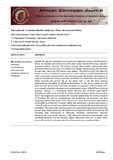| dc.description.abstract | Despite the regular inspections and current contingencies made in the HF plant at
Necsa, an isolated case where two mild steel vessels leaked HF during operation
occurred without warning. The failure of both these vessels necessitated their
premature decommissioning, and showed that better understanding the corrosion
of mild steel used in the HF industry was needed. The failure of the mild steel was
traced to nitric acid (HNO3) contamination in the sulphuric acid (H2SO4) feedstock
which eventually concentrated in the technical grade HF product downstream. A
study to simulate the industry corrosion conditions in a laboratory was required to
better estimate the service life of the steels used in the HF plant because
understanding the effect of HNO3 contamination on the plant’s steels and the
determination of corrosion inhibition strategies was essential. Unfortunately, HF is
an extremely hazardous chemical and concentrations above 70% HF have a fuming
capacity, making it a potentially lethal chemical for corrosion experiments.
Therefore, to safely work with HF, the safety risk for working with the chemical first
had to be categorised and assessed. This entailed determining the internal hazards
of handling HF and its consequences, the probability of exposure and then
mitigating actions that would lower the risk to a point that corrosion experiments
could safely be conducted. A regular safety risk assessment, a process description, a
“what if” analysis, as well as an external hazard and operability study (HAZOP) was
completed. This lead to the implementation of a specialized experimental setup that
proved to be prepared for any HF exposure contingencies while still producing HF
corrosion data comparable to literature. Moreover, preventative measures
including the use of HF resistant PPE (Personal Protective Equipment), well
ventilated facilities and HF resistant Teflon containers were put in place which
eventually resulted in the safe execution of corrosion tests completed there. | en_US |



